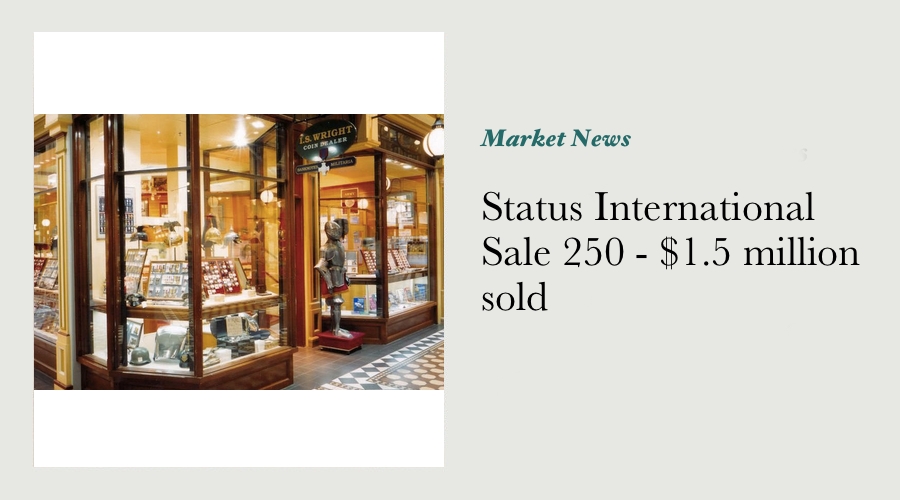Status International Sale 250 - $1.5 million sold

If any of you are waiting for a sub-million dollar auction result as further evidence that the world is going to hell in a handbasket, I hate to disappoint you but on that score the Status was pretty strong.
As a qualifier to that result, let's keep in mind that the clearance rate (the percentage of items that were auctioned that actually sold) was by my estimations around the 40% mark. (Putting the data in the prices realized document through a spreadsheet it comes out at 39.93%.) This figure will get better as buyers that were at the auction check in with the auctioneer to make further purchases after the auction has eneded.
So how should we interpret this result? A clearance rate of 40% for most auction houses would be regarded as a diabolical result, however that isn't necessarily the case for Status. When I bemoaned the fact that I wasn't able to buy much at the last Status Auction, Stewart Wright (the head man at IS Wright) quite accurately and uncharitably stated that it wasn't his job to ensure that dealers like me made profits! Which is true, as much as I'd like to think otherwise.
The reason I state that is that the reserves at Status Auction are probably a touch higher than they are at other auctions of similar material. These guys really know the wholesale market, and aren't in the business of giving stock away. Whereas at other auctions, dealers can go in and buy the majority of the stock on offer as it allows them a decent profit, there isn't the same degree of wholesale buying via Status - the margins don't permit it. So, to the degree that the clearance rate and prices realized result for Status shows the level of activity in the marketplace, we can say that a lot of buyers aren't active at present (the clearance rate at the last Status auction in May was around 52%), and those buyers that are active are selective with what they are buying.
This is pretty much my read on the current situation - it isn't that there is the same number of buyers in the market and they are spending less, it is the fact that the buyers that are in the market are still spending reasonable sums on the items they're after, it's more that there are less buyers in the market. Less buyer competition = lower prices realized for certain items.
My obsevations of the auction were that bids for RAM products had dropped off, whereas the secondary market for Perth Mint products seems to be still pretty healthy. The former is the case probably because there's been a bit of a bubble for it in recent years, and a lot of people have been buying it for speculative reasons. The latter would be the case due to the level of demand for bullion-based products. Physical metal is in very strong demand at the moment, good quantities of either gold or silver bullion are very difficult to come by. This is filtering upward into the quasi-numismatic market, where people are paying increasing premiums just to get their hands on some of the stuff.
Banknotes in average grade, both decimal and pre-decimal seem to have eased off a fair bit. This probably means they're getting back to more sensible levels, ie where quality notes still generate interest, while crap goes back to selling for a modest amount above face value, if at all.
The shipwreck coins didn't command a wide level of interest, although I must say it was hard to pick more than one or two coins that had good eye appeal - most seemed to have been harshly cleaned. The proclamation & colonial coins still sold well, probably because buyers of this stuff aren't as price-sensitive as they are for other segments, and there is an international market for those coins after all. Re the gold sovereigns and halves, anything attractive that had a reserve around the spot price was hoovered up, anything that was over-graded or over-priced was just disregarded. Ditto with the Commonwealth coins, key dates in premium grade moved well, junky stuff that wasn't good value just died in the water. The 1920 plain penny made around 19 thousand nett, and there was some competition for that, the less lousy of the two 1930 pennies sold in the high teens, the other didn't move. Goose dollars remain all the rage, and sold for between 700 and 900 nett.
There was the usual interest in the tokens, and some of the world coins made good prices, I expect the AUD value at present had something to do with that!